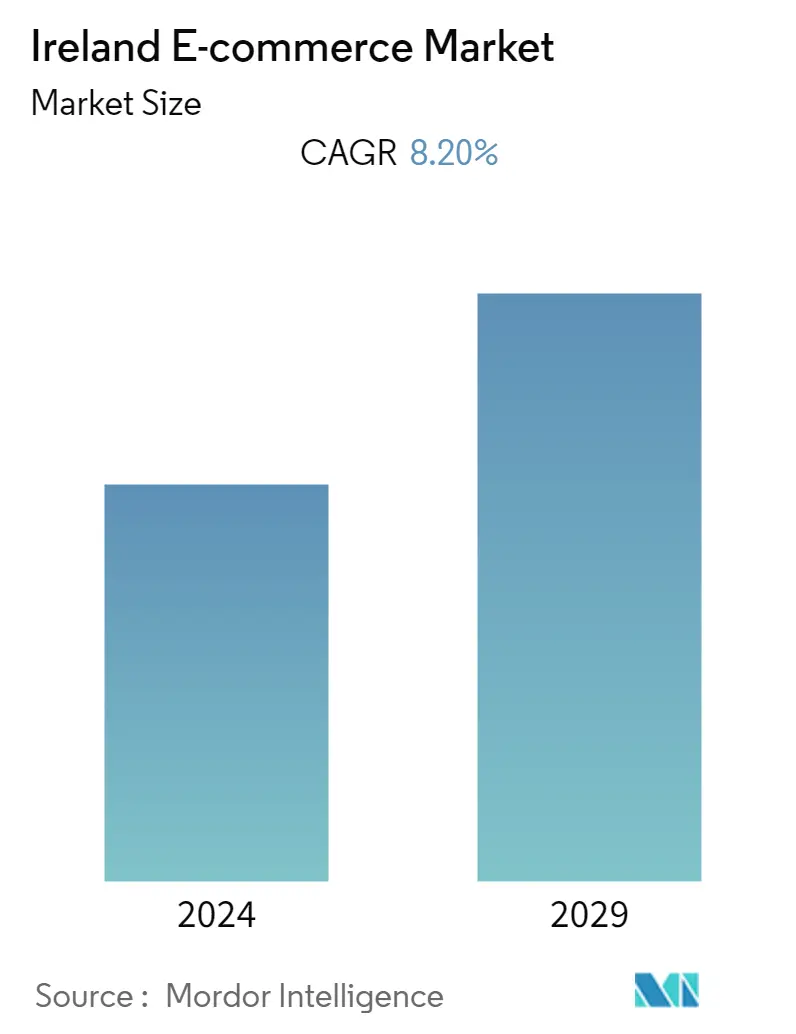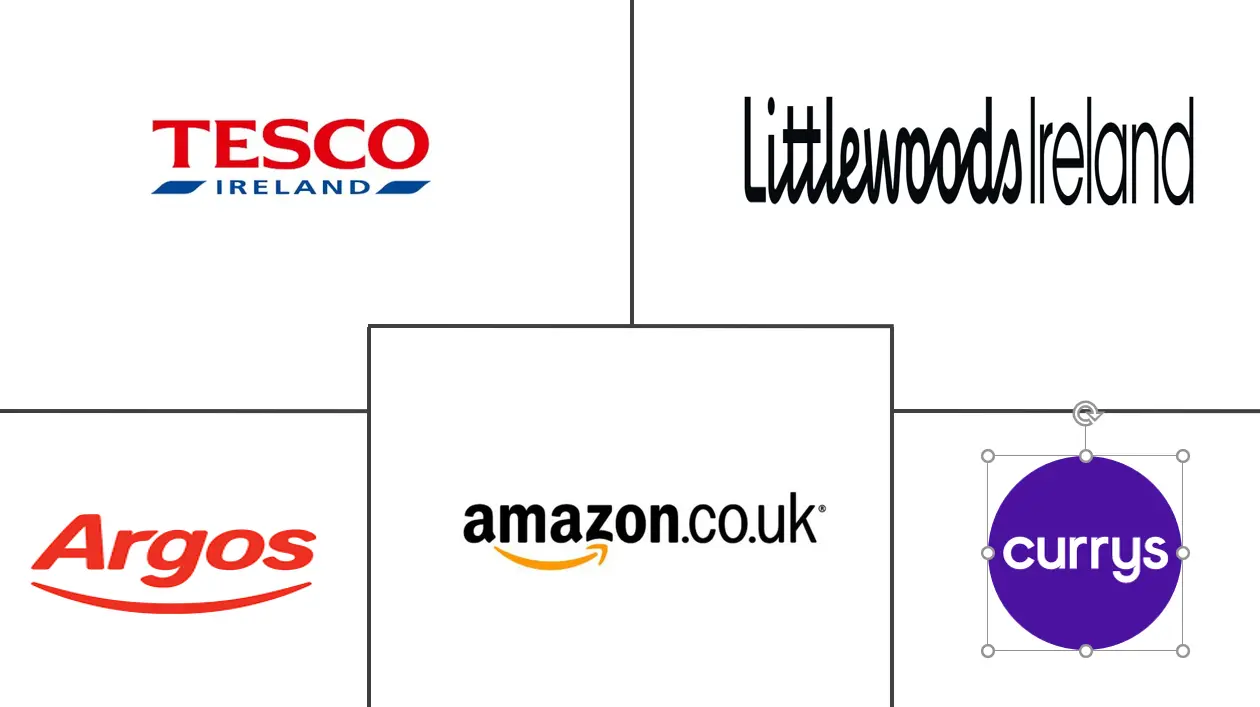Market Size of Ireland E-commerce Industry

| Study Period | 2019 - 2029 |
| Base Year For Estimation | 2023 |
| Forecast Data Period | 2024 - 2029 |
| Historical Data Period | 2019 - 2022 |
| CAGR | 8.20 % |
| Market Concentration | Low |
Major Players
*Disclaimer: Major Players sorted in no particular order |
Ireland E-commerce Market Analysis
The Ireland e-commerce market is expected to register a CAGR of 8.2% from 2022 to 2027. The primary factor driving the growth of the e-commerce market in the region are strong household internet access, high cross-border spending, and rising smartphone usage, among others.
- The key factors influencing the growth of e-commerce in Ireland include the ease, convenience, and security of the payment methods and online retailers investing in making their websites more appealing and user-friendly. The significant growth of alternate payment methods is also boosting the growth of the e-commerce market in the region. Bank transfers and digital wallets are Irish customers' two most used payment methods for online sales. Moreover, increasing smartphone penetration and the arrival of advanced digital wallet solution is further expected to grow the e-commerce market in the region.
- Furthermore, as per Central Statistics Office, Ireland, the proportion of retail sales generated online for All Retail Businesses was 6.5% in December 2021 and 6.0% in November 2021, compared to 5.8% in December 2020. Moreover, in December 2019, the proportion of retail sales transacted online for All Retail Businesses was 4.1%. The share of online generated sales continued to grow at 3.2% in January 2020, 3.5% in February 2020, and 4.5% in March 2020. the share of online sales in November 2020 was 12.4%, 11.0% in January 2021, and 11.8% in February 2021.
- Furthermore, the region's e-commerce market continues to expand faster, with mobile internet retailing becoming especially significant. Retailers in the region are launching dedicated mobile apps while store-based retailers rapidly utilize multi-channel options. Click and collect services have become more widely available, allowing retailers to maximize retail potential without incurring delivery fees. In contrast, the consumer can easily access purchases without planning for deliveries.
- Any security doubt or risk in the minds of consumers while shopping online can negatively affect consumers and their motives to purchase products or services online. Their main concern is the stealing of their credit card information. This factor can negatively impact the e-commerce market in the region.
- The COVID-19 outbreak has rapidly forced numerous entities (public, business, and private) to become predominantly oriented to e-commerce during the pandemic. Moreover, the pandemic accelerated the move to digital for Irish consumers. The pandemic has increased the scope of e-commerce and the range of services in Ireland despite the deteriorating economic and social situation.
Ireland E-commerce Industry Segmentation
E-commerce significantly impacts consumer behavior and is beneficial in many ways. Firstly, consumers do not have to step out and can shop from the comfort of their homes using any devices such as a laptop or even their mobile phones. Secondly, consumers can look into different websites to compare and contrast prices and find the cheapest rates available according to their needs.
The Ireland E-commerce Market is Segmented into B2C E-commerce (Beauty and Personal Care, Consumer Electronics, Fashion and Apparel, Food and Beverage, Furniture and Home), and B2B E-commerce.
| By B2C E-commerce | ||||||||
| Market Size (GMV) for the Period of 2017-2027 | ||||||||
|
| By B2B E-commerce | |
| Market Size for the Period of 2017-2027 |
Ireland E-commerce Market Size Summary
The e-commerce market in Ireland is experiencing robust growth, driven by factors such as widespread household internet access, high levels of cross-border spending, and increasing smartphone usage. The convenience and security of online payment methods, along with investments by online retailers to enhance website appeal and user-friendliness, are significant contributors to this expansion. The rise of alternative payment methods, particularly bank transfers and digital wallets, is further propelling the market. The COVID-19 pandemic has accelerated the shift towards digital shopping, expanding the scope of e-commerce and the variety of services offered, despite economic challenges. Mobile commerce is becoming increasingly important, with retailers launching dedicated mobile apps and utilizing multi-channel options to enhance customer experience.
The competitive landscape of Ireland's e-commerce market is marked by the presence of major players such as Amazon.co.uk, Tesco Ireland, and Argos Ireland Limited. These companies are expanding their market presence through new payment systems, strategic partnerships, and acquisitions. The fashion segment is witnessing a trend towards integrating shopping functionalities with social media, facilitating faster and more engaging customer conversions. Despite a decline in discretionary spending, consumers continue to purchase affordable fashion items online, influenced by fashion bloggers and social media. The government's support for card payments and the gradual rollout of 5G technology are expected to further boost the market, making Ireland a significant player in the e-commerce sector.
Ireland E-commerce Market Size - Table of Contents
-
1. MARKET INSIGHTS
-
1.1 Market Overview
-
1.2 Industry Attractiveness - Porter's Five Forces Analysis
-
1.2.1 Bargaining Power of Suppliers
-
1.2.2 Bargaining Power of Buyers/Consumers
-
1.2.3 Threat of New Entrants
-
1.2.4 Threat of Substitute Products
-
1.2.5 Intensity of Competitive Rivalry
-
-
1.3 Key Market Trends and Share of E-commerce of Total Retail Sector
-
1.4 Impact of COVID-19 on the E-commerce Sales
-
-
2. MARKET SEGMENTATION
-
2.1 By B2C E-commerce
-
2.1.1 Market Size (GMV) for the Period of 2017-2027
-
2.1.2 Market Segmentation - by Application
-
2.1.2.1 Beauty and Personal Care
-
2.1.2.2 Consumer Electronics
-
2.1.2.3 Fashion and Apparel
-
2.1.2.4 Food and Beverages
-
2.1.2.5 Furniture and Home
-
2.1.2.6 Others (Toys, DIY, Media, etc.)
-
-
-
2.2 By B2B E-commerce
-
2.2.1 Market Size for the Period of 2017-2027
-
-
Ireland E-commerce Market Size FAQs
What is the current Ireland E-commerce Market size?
The Ireland E-commerce Market is projected to register a CAGR of 8.20% during the forecast period (2024-2029)
Who are the key players in Ireland E-commerce Market?
Amazon.co.uk, Argos Distributors (Ireland) Limited, Tesco Ireland, Currys Ireland Limited and Littlewood Ireland are the major companies operating in the Ireland E-commerce Market.

